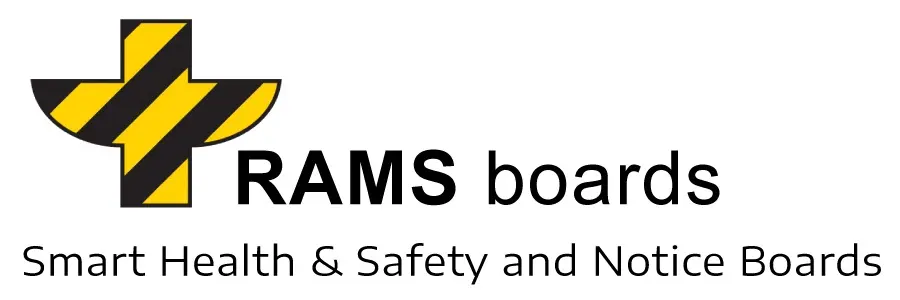The Role of Safety Accountability Mirrors in Workplace Safety
Visibility is a crucial factor in maintaining a safe work environment, particularly in areas with high traffic or blind spots. In warehouses, parking lots, road intersections, and construction sites, poor visibility can lead to accidents, including collisions between vehicles, pedestrians, and equipment. Safety mirrors, particularly convex and awareness mirrors, are designed to mitigate these risks by providing a broader field of view and reducing blind spots.
Safety mirrors are an essential component of modern workplace safety management.

They help organizations comply with traffic and pedestrian safety regulations by improving visibility and awareness in critical areas. For maintenance managers and office staff, installing these mirrors can significantly enhance safety outcomes and reduce liability by preventing avoidable accidents.
Leading providers such as Workplace Products, SafetyBuyer, RAMS Boards, and Barriers Direct offer a range of safety mirrors tailored to various environments. These solutions include both indoor and outdoor models, designed with durable materials like acrylic and polycarbonate to withstand weather conditions and impact. In addition to basic convex mirrors, some providers also offer accountability mirrors that promote personal responsibility by prompting workers to reflect—literally and figuratively—on their role in maintaining safety.
This article explores how safety mirrors contribute to enhanced visibility, compliance, and accident prevention, while also highlighting customization options, real-world applications, and future trends in safety technology.
Overview of Safety Mirror Providers
Several companies specialize in producing and distributing safety mirrors designed for workplace and traffic safety. These providers cater to a wide range of industries, offering customizable options to meet site-specific needs:
- Workplace Products: Offers a variety of convex safety mirrors suitable for warehouses, office parking areas, and loading zones. Their products emphasize improved visibility for both vehicles and pedestrians.
- SafetyBuyer: Supplies a broad range of safety mirrors, including indoor and outdoor options with shatter-resistant materials. They focus on solutions for compliance with traffic management and safety inspections.
- RAMS Boards: Known for their modular safety infrastructure, RAMS Boards also integrate accountability mirrors into their safety hubs, reinforcing both visibility and worker responsibility.
- Barriers Direct: A provider of traffic and pedestrian safety solutions, offering mirrors for use in road intersections, car parks, and facility entrances. Their products are often combined with other traffic management tools such as barriers and speed bumps.
These providers offer both off-the-shelf and customizable solutions, ensuring that organizations can enhance visibility and safety in any environment. Whether addressing visibility in a warehouse aisle or preventing collisions at a parking lot exit, these mirrors play a crucial role in reducing risks and improving compliance.
Types of Safety Mirrors and Their Features
Safety mirrors come in various designs, each tailored to improve visibility and safety in specific environments. Whether installed indoors or outdoors, these mirrors are engineered to reduce blind spots, enhance traffic awareness, and protect both workers and pedestrians. The most common types include convex mirrors and awareness mirrors, both of which provide practical solutions for accident prevention.
1. Convex Mirrors: Expanding the Field of View
Convex mirrors are curved outward to provide a wide-angle view, making them ideal for areas where blind spots pose a significant risk. These mirrors are commonly used in:
- Warehouses: Positioned at intersections where forklift operators and workers navigate narrow aisles, helping prevent collisions.
- Road Intersections and Parking Lots: Installed at sharp corners and driveways to improve visibility of oncoming traffic.
- Construction Sites: Used near heavy equipment and machinery to provide operators with a better view of their surroundings.

Convex mirrors help reduce accidents by giving users a panoramic view, eliminating hidden spots where people or vehicles might not otherwise be visible. Their effectiveness in high-traffic areas makes them a staple of workplace safety infrastructure.
2. Awareness Mirrors: Promoting Safety Accountability
Awareness mirrors go beyond visibility by promoting personal accountability for safety. Often referred to as “safety accountability mirrors,” these mirrors are strategically placed in areas where workers must pause and reflect on their actions. One popular design includes a built-in message, such as “Meet the person responsible for your safety,” encouraging users to take ownership of their safety behavior.

These mirrors are commonly found:
- At Entrances to Hazardous Zones: Workers are prompted to verify their safety gear and assess risks before entering.
- Near Emergency Equipment: Positioned next to fire extinguishers and first aid stations to reinforce the importance of prompt, responsible action.
- In Warehouses and Manufacturing Facilities: Used as a reminder for equipment operators to check for pedestrian clearance before proceeding.
This type of mirror plays a psychological role in reinforcing a culture of safety, which can lead to long-term behavioral improvements and fewer incidents.
3. Customizable Features for Specific Needs
Safety mirrors are available in various sizes, shapes, and materials, allowing companies to customize them for their specific environments. Customization options include:
- Materials:
- Acrylic: Lightweight and shatter-resistant, suitable for indoor use.
- Polycarbonate: Impact-resistant and durable, designed for outdoor applications where harsh weather or heavy traffic is a concern.
- Mounting Options: Mirrors can be wall-mounted, pole-mounted, or ceiling-hung, depending on the area’s layout and traffic patterns.
- Size and Coverage: Larger mirrors are often used at wide intersections or loading docks, while smaller models are appropriate for confined indoor spaces.
- Color Coding: Some mirrors feature brightly colored edges to increase visibility and attract attention in high-risk areas.
These customizable options ensure that safety mirrors can effectively address a wide range of workplace hazards, helping organizations tailor their safety infrastructure to their unique risks and requirements.
4. Durability and Longevity
Safety mirrors designed for industrial use are built to withstand demanding conditions. Outdoor mirrors, in particular, must endure exposure to elements such as rain, wind, and UV radiation. To enhance durability, manufacturers offer features such as:
- Anti-Fog Coatings: Prevent condensation build-up in humid environments.
- UV Resistance: Protects the mirror surface from fading or warping due to prolonged sun exposure.
- Scratch-Resistant Layers: Extends the lifespan of the mirror in areas where contact with debris or equipment is common.
By investing in durable, high-quality mirrors, organizations can reduce maintenance costs and ensure continuous safety visibility over the long term. In summary, both convex and awareness mirrors are vital tools for reducing blind spots and enhancing workplace safety. Customization options such as material selection, mounting styles, and durability features allow companies to implement solutions tailored to their specific needs.
Enhanced Visibility and Traffic Safety
Safety mirrors play a vital role in enhancing visibility and reducing traffic-related risks in workplaces, particularly in high-traffic and blind-spot areas. By providing a clear and expanded field of view, these mirrors help prevent collisions and accidents involving vehicles, equipment, and pedestrians. Their strategic placement in key areas, such as warehouses, construction sites, and parking lots, improves situational awareness and compliance with traffic safety regulations.
1. Applications in Warehouses and Loading Zones
Warehouses are bustling environments where forklifts, pallet jacks, and pedestrians often share the same space. Blind spots at aisle intersections and loading docks are common and pose a significant risk of collisions. Convex mirrors are widely used in these areas to provide operators with a full view of intersecting paths.
Key benefits of mirrors in warehouses include:
- Accident Prevention: Forklift operators can spot approaching traffic and pedestrians around corners, reducing the risk of collisions.
- Improved Workflow: By enhancing visibility, mirrors help minimize disruptions and delays caused by safety incidents.
- Pedestrian Protection: Pedestrians can check for moving vehicles before crossing paths, improving safety awareness.
Mirrors strategically positioned at high-traffic points improve overall traffic flow while ensuring that safety protocols are followed.
2. Traffic Management at Road Intersections and Parking Lots
In outdoor settings, such as road intersections, parking lots, and facility entrances, visibility issues are often caused by sharp corners, obstructed views, or poorly designed layouts. Safety mirrors help address these challenges by offering an extended view of approaching vehicles and pedestrians.
Applications in these areas include:
- Parking Lot Exits: Convex mirrors allow drivers exiting parking lots to see oncoming traffic, minimizing the risk of collisions.
- Road Intersections: Mirrors placed at intersections enhance visibility where road signs or structures obstruct the line of sight.
- Pedestrian Crossings: Mirrors increase awareness for both drivers and pedestrians at crossing points, improving reaction times and reducing accidents.
These measures help organizations comply with traffic safety regulations, particularly in areas with mixed vehicle and pedestrian traffic.
3. Safety Solutions on Construction Sites
Construction sites often feature a mix of heavy machinery, delivery trucks, and workers on foot, all operating in close proximity. Limited visibility due to equipment size, site layout, and moving materials makes mirrors essential for traffic safety.
Safety mirrors are commonly installed near:
- Heavy Machinery Zones: Mirrors provide equipment operators with a wider view of their surroundings, helping them avoid accidents when reversing or turning.
- Site Entrances and Exits: Traffic control mirrors improve visibility for vehicles entering and leaving the site, reducing the risk of collisions with pedestrians or other vehicles.
- Blind Spots Around Temporary Structures: Construction sites often change frequently, and temporary structures like scaffolding can create new blind spots. Mirrors placed strategically around these areas help maintain visibility.
By reducing the risk of collisions, safety mirrors contribute to smoother operations and better compliance with construction site safety protocols.
4. Preventing Traffic-Related Incidents
Traffic-related accidents are among the leading causes of workplace injuries, particularly in environments with frequent vehicle movement. Safety mirrors address these risks by:
- Increasing Reaction Time: Workers and drivers can spot hazards earlier, giving them more time to take preventive action.
- Enhancing Situational Awareness: Mirrors encourage users to be more mindful of their surroundings, particularly in high-risk areas with complex traffic patterns.
- Supporting Traffic Flow: By reducing the need for manual interventions (e.g., traffic controllers or stop signs), mirrors help maintain efficient movement of vehicles and materials.
Regular inspection and maintenance of mirrors are essential to ensure their effectiveness. Cleaning and checking for damage, such as cracks or misalignment, help maintain clear visibility and reduce the risk of accidents.
5. Complementary Traffic Safety Tools
Safety mirrors are often used alongside other traffic safety solutions to create a comprehensive safety strategy. Common complementary tools include:
- Barriers and Bollards: These physical structures help separate pedestrian walkways from vehicle paths, reducing the likelihood of collisions.
- Speed Control Measures: Mirrors are often installed near speed bumps or other speed control devices to improve visibility at critical points.
- Warning Signs and Lighting: In areas with limited natural light, mirrors combined with reflective signs and additional lighting improve visibility for both drivers and pedestrians.
These combined measures reinforce traffic safety and help organizations meet regulatory requirements for workplace safety management. In conclusion, safety mirrors are a cost-effective and reliable solution for enhancing visibility and reducing traffic risks in a variety of work environments. Their role in preventing collisions, improving traffic flow, and protecting pedestrians makes them an essential part of workplace safety infrastructure.
Workplace Safety Management and Compliance
Workplace safety is a top priority for businesses, especially in environments with heavy equipment, frequent vehicle movement, and shared pedestrian paths. Ensuring compliance with safety regulations requires effective communication, risk management, and regular safety inspections. Safety mirrors play a crucial role in this effort by helping organizations improve visibility, protect workers, and reduce liability in the event of accidents. By integrating safety mirrors into their overall safety strategy, companies can better adhere to regulatory requirements and maintain a safe work environment.
1. Supporting Compliance with Traffic and Safety Regulations
Workplace safety regulations often require businesses to take preventive measures to manage traffic risks and blind spots. Organizations in industries such as logistics, construction, and manufacturing must comply with standards related to:
- Safe Traffic Management: Regulations may mandate measures to reduce the risk of vehicle-pedestrian collisions, particularly in high-traffic zones. Convex mirrors help meet this requirement by improving visibility at intersections and blind corners.
- Emergency Access and Exit Routes: Safety codes require clear access to emergency exits and paths. Mirrors near loading docks and warehouse exits can prevent blockages caused by vehicle or equipment traffic.
- Inspection Readiness: During safety audits, inspectors evaluate visibility hazards and risk management practices. The presence of safety mirrors demonstrates that a company is proactively addressing visibility challenges and traffic control risks.
Adhering to these regulations helps prevent workplace injuries and reduces the risk of fines or legal penalties from non-compliance.
2. Integration with Safety Management Programs
Safety mirrors are an important component of broader workplace safety management systems. They work in tandem with other safety measures, such as training programs, signage, and personal protective equipment (PPE), to create a comprehensive risk management strategy. Key areas of integration include:
- Safety Inspections: Mirrors are regularly inspected and maintained to ensure they provide a clear and unobstructed view. Inspections are typically scheduled alongside other equipment checks as part of routine safety audits.
- Training and Awareness: Workers are trained to use mirrors effectively, learning to check for hazards at intersections and blind spots before proceeding. This reinforces safe operating practices, particularly for equipment operators and drivers.
- Incident Reporting and Analysis: Mirrors are positioned based on data from incident reports and near-miss events. By analyzing traffic patterns and accident history, safety teams can identify high-risk areas and install additional mirrors to prevent future incidents.
These measures ensure that mirrors contribute to ongoing safety improvement and compliance with workplace policies.
3. Enhancing Pedestrian and Worker Protection
In workplaces where pedestrians and vehicles interact, safety mirrors provide a crucial line of defense. Common scenarios include:
- Crosswalks and Pathways: Pedestrian crosswalks in warehouses and parking lots often intersect with forklift or vehicle paths. Mirrors increase awareness for both parties, reducing the risk of collisions.
- Loading Zones: Workers loading or unloading goods are at risk of being struck by vehicles. Mirrors positioned near loading bays provide a clear view of approaching traffic, helping workers stay alert to potential hazards.
- Equipment Operation Areas: Mirrors give machine operators a broader field of view, helping them detect workers who may be in their blind spots.
By improving visibility, safety mirrors reduce the risk of both minor accidents and serious injuries, ensuring safer interactions between people and equipment.
4. Promoting Accountability Through Awareness Mirrors
Accountability mirrors encourage workers to take personal responsibility for their safety actions.
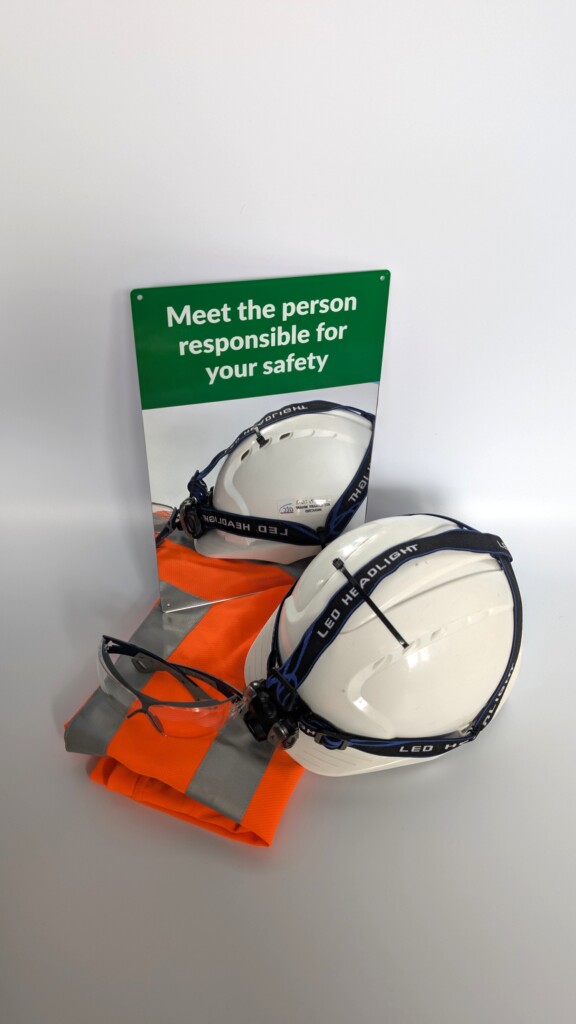
These mirrors, often placed near high-risk areas, include prompts that remind users to reflect on their safety practices. For example, mirrors displaying messages like “Meet the person responsible for your safety” promote greater awareness and reinforce a culture of safety.
This approach helps workers internalize safety protocols, making them more likely to adhere to traffic rules, wear PPE, and follow proper procedures. Over time, this consistent reinforcement leads to behavioral changes that contribute to fewer incidents and greater compliance with safety policies.
5. Benefits for Compliance Audits and Inspections
Safety mirrors also enhance an organization’s performance during audits and inspections. Inspectors assess visibility hazards and the effectiveness of traffic management strategies when determining compliance with safety regulations. Well-maintained safety mirrors demonstrate that a company is actively managing visibility risks, which can result in:
- Positive Inspection Outcomes: Companies with effective visibility solutions are more likely to receive favorable audit reports, reducing the risk of regulatory penalties.
- Improved Reputation: Demonstrating a commitment to safety through proactive measures, such as the use of mirrors and other traffic controls, enhances a company’s standing with clients, employees, and regulators.
- Reduced Liability: In the event of an accident, documented evidence of preventive measures (e.g., installed mirrors and routine maintenance) can help mitigate legal liability and claims.
6. Routine Maintenance and Compliance Assurance
To maintain their effectiveness, safety mirrors require regular cleaning, alignment checks, and damage inspections. Maintenance schedules are often incorporated into broader compliance programs, ensuring that mirrors continue to meet safety standards. Tasks may include:
- Cleaning to Remove Dust and Debris: Dirt and fog can obscure visibility, making regular cleaning essential in environments like construction sites or outdoor facilities.
- Alignment Adjustments: Mirrors can shift over time due to vibration or weather. Regular checks ensure that mirrors remain properly positioned to provide optimal visibility.
- Damage Repairs: Cracked or scratched mirrors can reduce effectiveness. Prompt repairs or replacements are necessary to maintain safety compliance.
By integrating safety mirrors into workplace safety management programs, companies can better protect their employees, reduce traffic-related incidents, and maintain compliance with safety regulations.
Customization Options and Durability
Safety mirrors are available in a range of customizable options to meet the diverse needs of various work environments. From material selection to mounting styles, these features help ensure that mirrors are both effective and durable. Customization allows businesses to implement solutions that align with specific hazards, traffic patterns, and environmental conditions, while durability features minimize maintenance and replacement costs.
1. Materials Designed for Impact and Weather Resistance
The material used in safety mirrors is a crucial factor in determining their durability and suitability for different environments. Manufacturers offer a variety of materials, each tailored to specific applications:
- Acrylic Mirrors:
- Lightweight and shatter-resistant, acrylic mirrors are commonly used indoors in warehouses and offices.
- They provide excellent optical clarity but may be less impact-resistant than other materials.
- Polycarbonate Mirrors:
- Known for their high impact resistance, polycarbonate mirrors are ideal for outdoor use in areas with heavy equipment and vehicle traffic.
- They can withstand harsh weather conditions, including rain, wind, and extreme temperatures, without cracking or fading.
- Stainless Steel Mirrors:
- Used in high-security or industrial environments, stainless steel mirrors offer superior durability and resistance to vandalism.
- They are often installed in locations where impact or tampering is a concern, such as public facilities or transportation hubs.
Choosing the right material helps organizations maximize the lifespan of their mirrors while minimizing the need for frequent repairs or replacements.
2. Size and Coverage Options
The size of a safety mirror influences its field of view and effectiveness in reducing blind spots. Custom sizing options allow companies to select mirrors that fit their specific site layouts and visibility requirements:
- Small Mirrors:
- Used in confined spaces such as narrow warehouse aisles or hallways, where large mirrors may obstruct movement.
- Medium-Sized Mirrors:
- Commonly installed at intersections in warehouses, parking lots, and roadways to provide visibility for moderate traffic flow.
- Large Mirrors:
- Ideal for open areas with high-speed traffic, such as construction site entrances or main access roads. These mirrors offer a wide-angle view, allowing operators to monitor multiple hazards simultaneously.
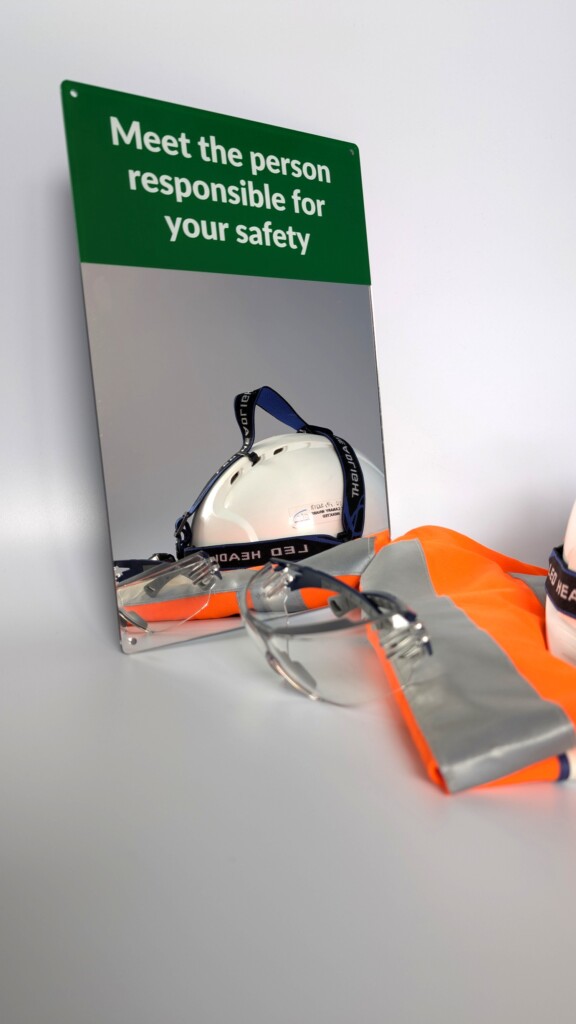

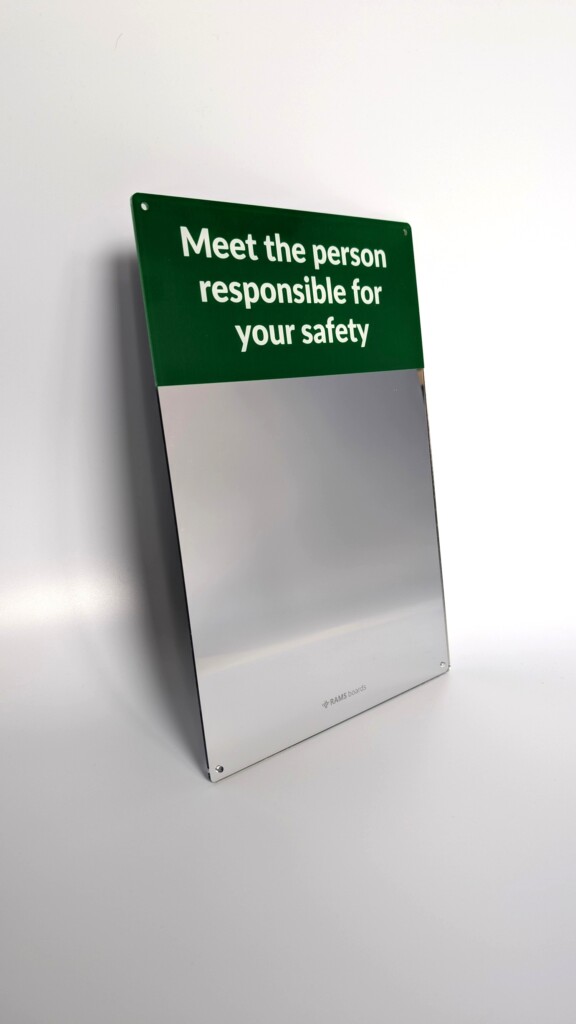
By choosing the appropriate size, businesses can ensure that mirrors provide optimal visibility without causing distractions or obstructions.
3. Mounting and Installation Options
Proper placement and installation are critical to the effectiveness of safety mirrors. Manufacturers offer various mounting options to accommodate different site conditions and traffic patterns:
- Wall-Mounted Mirrors:
- Suitable for indoor use in hallways and near exits.
- These mirrors are mounted directly on walls, providing a stable and unobtrusive solution for pedestrian areas.
- Pole-Mounted Mirrors:
- Commonly used outdoors, particularly at intersections, parking lots, and construction sites.
- Pole-mounted mirrors can be adjusted to various heights, ensuring visibility for both drivers and pedestrians.
- Ceiling-Hung Mirrors:
- Installed in areas with overhead hazards, such as warehouse loading zones.
- These mirrors help operators monitor high-risk areas without the need for ground-level installations.
The flexibility of mounting options allows businesses to position mirrors strategically, improving traffic control and hazard monitoring.
4. Additional Custom Features
Many manufacturers offer optional features to enhance the functionality and durability of safety mirrors, including:
- Anti-Fog and Anti-Condensation Coatings:
- Prevent moisture build-up in humid environments, ensuring that mirrors remain clear and visible.
- UV Protection:
- Protects outdoor mirrors from discoloration and surface degradation caused by prolonged sun exposure.
- Colored Borders:
- Brightly colored edges (e.g., red or yellow) increase visibility, drawing attention to the mirror’s location in high-risk areas.
- Integrated Signage:
- Some mirrors come with built-in warning signs or directional indicators to provide additional safety guidance.
These custom features enhance the effectiveness of mirrors in both indoor and outdoor environments, improving visibility and worker awareness.
5. Indoor vs. Outdoor Applications
While some safety mirrors are versatile enough for both indoor and outdoor use, specific designs cater to the unique challenges of each environment:
- Indoor Mirrors:
- Typically used in warehouses, offices, and retail spaces to reduce blind spots near entrances, intersections, and pedestrian walkways.
- Indoor mirrors prioritize lightweight materials and ease of installation.
- Outdoor Mirrors:
- Designed to withstand harsh weather conditions, outdoor mirrors are installed in parking lots, construction sites, and access roads.
- These mirrors are often made from impact-resistant polycarbonate or stainless steel to handle heavy traffic and environmental exposure.
Selecting the appropriate mirror for each location helps maintain long-term effectiveness while minimizing the risk of damage.
6. Cost Efficiency and Longevity
Investing in durable, customizable safety mirrors can yield long-term cost savings by reducing the need for frequent maintenance and replacements. High-quality materials and protective features help mirrors withstand daily wear and tear, making them a cost-effective addition to any workplace safety strategy.
By implementing mirrors tailored to their specific needs, organizations can improve both safety outcomes and compliance with regulatory standards, ultimately enhancing worker protection and traffic management.
Real-World Applications of Safety Mirrors
Safety mirrors have proven their effectiveness across various industries by preventing accidents, enhancing visibility, and supporting compliance with workplace safety regulations.
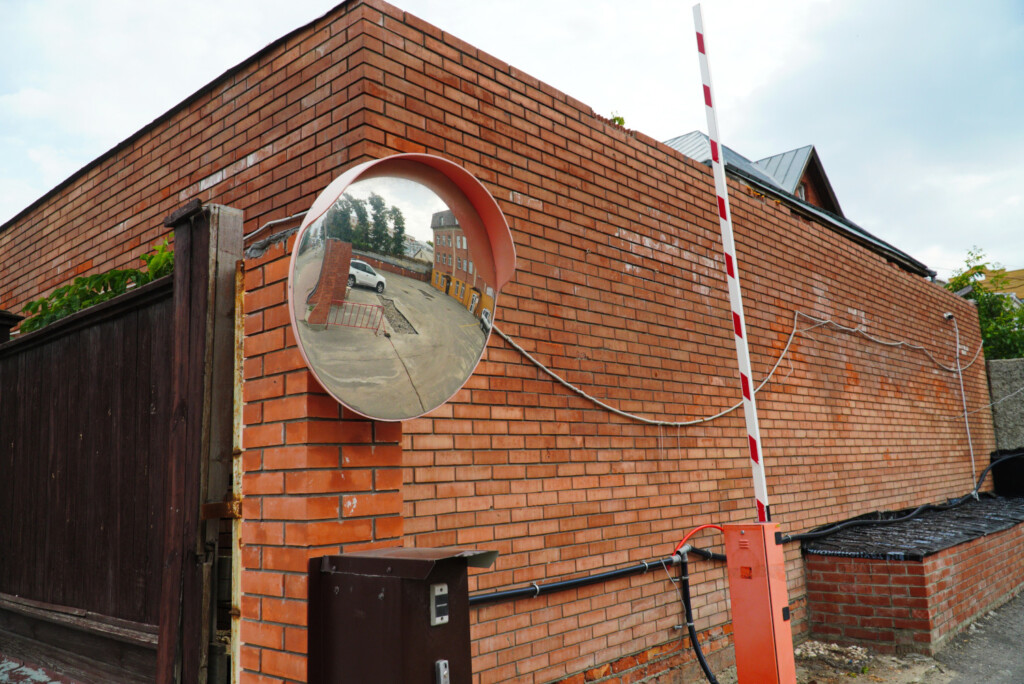
From warehouses to construction sites and office facilities, these mirrors are used to address specific risks related to traffic, blind spots, and pedestrian safety. Below are examples of real-world applications where safety mirrors have significantly improved safety outcomes.
| Application | Details |
|---|---|
| Warehouse Operations | Convex safety mirrors at intersections reduced forklift collisions by 35% by improving visibility and situational awareness in high-traffic aisles. |
| Construction Site Traffic Control | Pole-mounted mirrors near blind spots and intersections decreased near-miss incidents by 40%, enhancing vehicle and pedestrian safety. |
| Office Parking Lots | Mirrors at blind corners and exits improved visibility, reducing close-call pedestrian incidents and improving traffic flow within the lot. |
| Manufacturing Facility | Mirrors positioned at machine corners reduced equipment-related accidents by 30%, promoting awareness of obstacles and pedestrian movements. |
| Retail Distribution Center | Ceiling-hung mirrors at loading docks improved traffic coordination, reducing delays and safety risks from congestion. |
| Public Facility Entrance | Stainless steel convex mirrors at entrances provided better visibility, leading to fewer pedestrian-related incidents around buses and taxis. |
| Hospital Emergency Zones | Installed mirrors near ambulance entry points improved visibility for emergency vehicles, reducing risks of collisions during critical operations. |
| Airport Terminal Access Roads | Mirrors in high-turn areas reduced vehicle collisions near terminal access points by increasing visibility around tight bends and pedestrian zones. |
| Educational Campus Crosswalks | Convex mirrors installed at crosswalk intersections increased pedestrian safety, especially near school bus routes. |
| Mining Operations | Mirrors in underground tunnels improved equipment maneuverability and reduced risks of vehicle and worker collisions in confined spaces. |
| Shopping Mall Loading Bays | Mirrors positioned in delivery zones enhanced driver awareness and prevented accidents in crowded loading areas with limited line of sight. |
| Railway Station Platforms | Visibility mirrors at platform entrances reduced hazards by allowing operators and passengers to monitor oncoming trains and pedestrian movements. |
Future Trends in Safety Visibility Solutions
As industries continue to innovate in workplace safety, advancements in safety mirrors and visibility solutions are shaping how organizations manage traffic, blind spots, and hazard awareness. Emerging trends include the integration of technology, enhanced materials for durability, and a focus on sustainability. These innovations aim to make safety communication more effective, adaptable, and environmentally friendly.
1. Advanced Mirror Technology
Safety mirrors are evolving to include features that improve functionality and adaptability. These advancements enhance visibility in both indoor and outdoor environments, particularly in areas with changing conditions. New technologies include:
- Shatter-Resistant Coatings: Mirrors designed with advanced impact resistance are ideal for high-traffic industrial sites and public spaces where accidental damage is common.
- Anti-Glare and Light Diffusion Technology: Reduces glare caused by direct sunlight or vehicle headlights, ensuring clear visibility at all times.
- Enhanced Optical Clarity: Advances in mirror curvature and material manufacturing provide a more accurate reflection, helping users judge distances and obstacles more effectively.
These features increase the longevity and effectiveness of mirrors, minimizing maintenance needs while maximizing safety performance.
2. Integration with Digital Safety Tools
Digital integration is becoming a key trend in safety management, with mirrors being combined with other technologies such as cameras, sensors, and automation systems. These hybrid solutions offer real-time data collection and monitoring, improving both situational awareness and risk management. Examples of digital integration include:
- Camera-Enhanced Mirrors: Some mirrors are equipped with embedded cameras that provide additional visibility to remote operators through digital screens. This technology is particularly useful for monitoring blind spots in large facilities.
- Sensor-Activated Alerts: Mirrors connected to motion sensors can trigger visual or audio alerts when vehicles or pedestrians enter a hazardous zone. This system helps prevent collisions by warning both drivers and workers of potential risks.
- Data Analytics and Monitoring: Integrated platforms collect data on traffic patterns and incidents, enabling companies to identify high-risk areas and optimize mirror placement for maximum safety.
These smart systems enhance the role of mirrors by making them part of a larger network of safety tools.
3. Sustainability and Eco-Friendly Design
The growing emphasis on sustainability is influencing how safety mirrors are manufactured and maintained. Companies are adopting eco-friendly materials and processes to reduce the environmental impact of their safety infrastructure. Key sustainability initiatives include:
- Recycled Materials: Mirrors made from recycled polycarbonate and acrylic help minimize waste without compromising durability.
- Energy-Efficient Manufacturing: Some manufacturers are shifting to renewable energy sources and lower-carbon production methods.
- Modular and Reusable Designs: Mirrors that can be easily relocated and repurposed reduce the need for new installations, promoting long-term sustainability in workplace operations.
Organizations that prioritize sustainable safety solutions can align with broader corporate environmental goals while maintaining compliance with safety standards.
4. Personalized and Adaptive Safety Solutions
Future safety visibility solutions will increasingly focus on customization and adaptability to address site-specific risks. This includes personalized safety mirrors that can adjust to varying conditions or roles. Examples of adaptive solutions include:
- Adjustable Mirror Curvature: Some mirrors are being developed with adjustable curvatures, allowing site managers to fine-tune visibility angles based on changing traffic patterns.
- Custom Messaging and Signage: Mirrors integrated with digital screens can display real-time safety messages, traffic updates, and alerts, enhancing communication in dynamic environments.
- Industry-Specific Configurations: Companies in construction, logistics, and healthcare are adopting mirrors designed to meet their particular needs, such as specialized coatings for chemical resistance or anti-fog features for cold storage facilities.
These personalized options ensure that mirrors remain relevant and effective as workplace risks evolve.
5. Worker Engagement and Behavioral Safety Programs
The future of safety visibility solutions emphasizes behavioral safety—encouraging workers to take personal responsibility for their actions through consistent engagement. Mirrors equipped with accountability prompts, such as motivational messages or performance tracking, are gaining popularity in this context.
Innovative approaches to worker engagement include:
- Safety Challenges and Incentives: Workers may be rewarded for consistently following safety protocols, with performance data tracked and displayed on safety platforms.
- Behavioral Nudges: Mirrors placed near high-risk areas serve as visual cues to remind workers of their responsibilities, helping them stay alert and proactive in maintaining safety.
- Training Integration: Safety mirrors are being used as part of interactive training programs, where workers practice situational awareness and hazard identification using real-world scenarios.
These strategies contribute to long-term improvements in safety culture, reducing the likelihood of incidents caused by human error.
6. Expanded Applications Across Industries
As visibility solutions continue to evolve, their applications are expanding beyond traditional industrial and traffic settings. Emerging industries and environments adopting safety mirrors include:
- Healthcare Facilities: Mirrors are being installed in hospital corridors and emergency access areas to improve visibility for staff, patients, and visitors.
- Retail and Public Spaces: Shopping centers and transit hubs are using safety mirrors to enhance pedestrian safety in parking lots, loading zones, and crowded areas.
- High-Tech Manufacturing: Factories with automated systems and robotic equipment are integrating mirrors to support both human oversight and machine navigation.
These expanded applications reflect a growing recognition of the importance of visibility in maintaining safety and efficiency across diverse sectors.
As these trends continue to shape workplace safety, mirrors will become more sophisticated, sustainable, and adaptable. Companies that invest in these solutions can enhance both safety performance and regulatory compliance, ensuring a safer and more efficient future for their operations.
Improving Workplace Safety with Accountability Mirrors
Visibility is a critical element of workplace safety, particularly in environments with high traffic, blind spots, and complex operational hazards. Safety mirrors, including convex and awareness models, have become indispensable tools in improving visibility, reducing risks, and supporting compliance with safety regulations. By incorporating these solutions into their safety strategies, organizations can prevent accidents, protect workers, and enhance the efficiency of daily operations.
Recap of Benefits
The integration of safety mirrors provides a range of benefits across industries, including:
- Enhanced Visibility: Convex mirrors reduce blind spots and improve sightlines, making it easier for operators and pedestrians to spot potential hazards.
- Accident Prevention: By offering a broader field of view, safety mirrors help prevent collisions between vehicles, equipment, and pedestrians.
- Behavioral Safety Improvements: Accountability mirrors encourage workers to reflect on their actions and take personal responsibility for maintaining safety protocols.
- Customization and Durability: Mirrors can be tailored to specific environments, with materials designed to withstand impacts and harsh weather conditions.
- Regulatory Compliance: Safety mirrors demonstrate a company’s commitment to risk management and compliance, which can lead to favorable outcomes during audits and inspections.
These benefits make safety mirrors a cost-effective and reliable solution for managing traffic and visibility risks in both indoor and outdoor settings.
Expanding Use Across Industries
Organizations in various industries have successfully implemented safety mirrors to enhance visibility and safety. Warehouses, construction sites, healthcare facilities, and office complexes all face unique risks that can be mitigated through proper mirror placement and usage. Whether reducing forklift collisions in a logistics center or improving pedestrian safety in a parking lot, mirrors provide a versatile solution for managing complex safety challenges.
Additionally, industries are exploring innovative applications of safety mirrors, such as combining them with digital safety tools, motion sensors, and real-time alerts. These integrated systems further improve hazard awareness and response times, paving the way for smarter safety infrastructure.
Future Considerations
As safety technology continues to evolve, companies will have opportunities to adopt more advanced, sustainable solutions. Key developments include:
- Smart Visibility Systems: Mirrors with embedded cameras and sensors provide real-time feedback to operators, enhancing situational awareness in high-risk environments.
- Eco-Friendly Materials: Mirrors made from recycled and biodegradable materials support sustainability initiatives without compromising durability.
- Personalized Safety Solutions: Adaptive mirrors with features such as adjustable curvature, digital messaging, and custom signage will allow companies to tailor their safety infrastructure more precisely to their needs.
By staying ahead of these trends, organizations can maintain a competitive edge in both safety performance and regulatory compliance.
For maintenance managers, safety officers, and office administrators, improving workplace safety starts with a thorough assessment of visibility risks. Areas prone to blind spots, high traffic, or limited visibility should be prioritized for mirror installations.
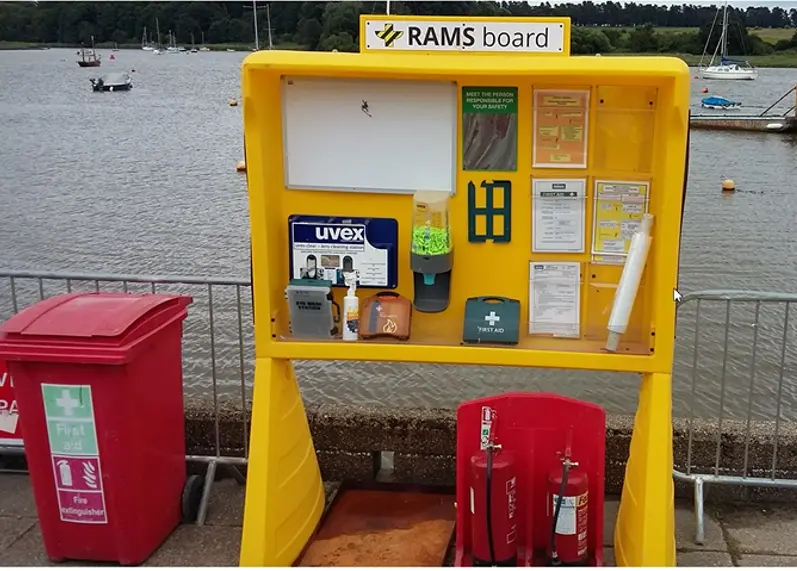
Collaborating with trusted providers like Workplace Products, SafetyBuyer, RAMS Boards, and Barriers Direct ensures that companies receive customized solutions tailored to their specific operational needs.
Safety mirrors are not just passive fixtures—they are an essential component of a comprehensive safety management plan. Investing in high-quality, durable mirrors today can prevent costly accidents and improve worker safety for years to come. Companies that prioritize visibility solutions will foster a safer, more productive workplace, protecting both their employees and their bottom line.
What are safety accountability mirrors, and how do they improve workplace safety?
Safety accountability mirrors are designed to promote personal responsibility and safety awareness. These mirrors are often placed in high-risk areas and include motivational prompts, such as “Meet the person responsible for your safety.” The reflective surface serves as both a visibility tool and a psychological reminder for workers to check their surroundings, safety gear, and actions. By reinforcing safe behavior, these mirrors contribute to a long-term improvement in workplace safety culture.
Where are safety accountability mirrors typically installed?
Safety accountability mirrors are strategically placed in locations where heightened awareness is critical, including: Entrances to hazardous work zones, prompting workers to verify safety measures before entering. Near emergency equipment, such as fire extinguishers and first aid kits, encouraging workers to act quickly and responsibly in emergencies. High-traffic intersections in warehouses and loading zones, helping both equipment operators and pedestrians stay alert and minimize collisions. These installations help reduce risks by improving both visibility and safety awareness.
What materials are commonly used for safety mirrors, and how do I choose the right one?
Safety mirrors are typically made from three materials: Acrylic: Lightweight and shatter-resistant, suitable for indoor environments like warehouses and offices. Polycarbonate: Highly impact-resistant and weatherproof, making it ideal for outdoor use or areas with heavy equipment. Stainless Steel: Extremely durable and vandal-resistant, often used in high-security or public spaces. Choose the material based on the location’s conditions (e.g., exposure to weather, traffic volume) and the level of durability required.
How do safety mirrors help organizations comply with workplace safety regulations?
Safety mirrors contribute to regulatory compliance by reducing blind spots and improving traffic safety in high-risk areas. Many safety standards require businesses to implement visibility measures, especially where vehicles and pedestrians interact. Mirrors positioned at intersections, entrances, and exits enhance situational awareness, preventing accidents and demonstrating a commitment to safety. During audits, inspectors often view the presence of well-maintained safety mirrors as evidence of proactive risk management, helping organizations pass inspections and avoid penalties.
